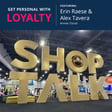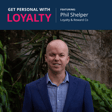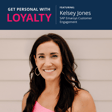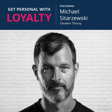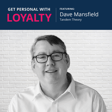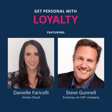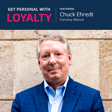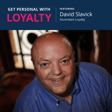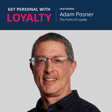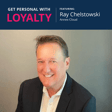Become a Creator today!Start creating today - Share your story with the world!
Start for free
00:00:00
00:00:01

Using Technology to Improve Customer Touchpoints (ft. Sukumar Muthya)
This episode’s guest is Sukumar Muthya, EVP of Loyalty at Ansira. Over the past 9+ years with Ansira, Sukumar has been dedicated to loyalty program design, program management and technology selection. Listen as we take a deep dive into integrated loyalty and how it goes beyond loyalty programs. Gain important insights from Sukumar’s extensive knowledge of customer touchpoints and how they can be improved through technology and building loyalty into a brand's overall stack to provide a holistic view of consumer experiences and demand generation.
Transcript
Introduction to Loyalty Programs
00:00:10
Speaker
Get personal with loyalty, where we're discussing using loyalty to deliver personalized, relevant customer experiences. Hello, everyone. Welcome to today's podcast. Today I'm here with Sukumar Muthia from ANSIRA. He is the Executive Vice President of Integrated Loyalty. Welcome, Sukumar. Thank you very much, Aaron. It's a pleasure to be here with you.
Sukumar's Career Path
00:00:35
Speaker
We're excited to have this conversation today. Before we get started, we'd love to learn a little bit more about your background and how you got into loyalty, because I don't know that story. Interesting career track that I have.
00:00:54
Speaker
I started actually in supply chain way back 28 years ago, and then I've always been a very curious individual working on trying to understand customer problems, how to solve their problems through technology, and then I
00:01:10
Speaker
Got my background in industrial engineering and then did my thesis in artificial intelligence back in 94 and then got into the supply chain part of it. And then I was working on supply chain transportation forecasting logistics warehouse management systems and so on and so forth. So I did that for about a decade.
00:01:31
Speaker
Management scenarios and then I got an opportunity to work in the marketing side of the things. So this was early in 2000, 2004, 2005 timeframe where direct marketing was still a big deal. So I got an opportunity to work in the marketing side of the house and then from that time on no turning back.
00:01:53
Speaker
I really enjoy marketing technology part of it. The primary reason is it's one of the areas where technology is embraced very, very quickly. And it's always brands that are always looking at learning and testing and experimentation on newer things compared to supply chain.
Integrated Loyalty Explained
00:02:13
Speaker
And that gives you an opportunity to be a new day every day.
00:02:17
Speaker
new culture every day, new clients every day, new challenges, new problems. So I got into like marketing technology, I mean, database marketing, campaign management, data modeling. And then from that point on, it's all about different pieces of marketing technology, whether it's customer experience, loyalty, and that kind of thing. So I've been specifically on the loyalty space. I've been working for the last eight to nine years in loyalty, program design, program management.
00:02:45
Speaker
And then technology selection and so forth. So that's that's been the journey. And, you know, I've been with answer for like nine plus years now. Wow. And managed integrated loyalty business unit. OK, and I have to ask you about that integrated loyalty, not just.
00:03:03
Speaker
executive vice president of loyalty, but integrated loyalty. So explain that. Why integrated? It is. It is interesting. See, this is this is exactly the reason why we called integrated loyalty, because we wanted to attract people to. Oh, you know, this is different. So you want to see what that is. Right. So integrated loyalty is not just the loyalty program, because you think today, right. So companies service, loyalty service providers also, you know, they're focused on
00:03:30
Speaker
Solely and designing loyalty program, running loyalty programs and that kind of thing. But what we wanted to do is we wanted to take it beyond
Building Loyalty Beyond Transactions
00:03:38
Speaker
loyalty. Everyone talks about loyalty program. Nobody talks about loyalty. That's what people talk about today. So how do you build loyalty to the brand? So it goes beyond the program. So it starts with knowing your customer. It starts with understanding how they are interacting with the brand.
00:03:54
Speaker
How much do we know about them and then attracting them to come back to your brand and then keeping them retaining them and creating compelling contextual personalized engagements with the customer, right? So whether that starts with data services, that starts with analytics, that starts with creative, that starts with cross channel campaign management.
00:04:14
Speaker
And then eventually at the core of it is still a loyalty program. But all of these services around that, we integrate it together. It's a portfolio of services that we offer to our clients with the idea that we help brands build loyalty when customers are not just in the buying cycle. So even if they are not in the buying cycle, they have to think about the brand. So how can we do that by doing these kind of things? So that's really how
00:04:42
Speaker
we coined the term integrated loyalty to bring all this portfolio of services together. I love that. I don't know that enough people are really thinking about that today. Well, I love the integrated part, but the fact that you still need to be building that relationship in between the transactions and being able to focus on that. What does that mean? Does it mean education? Does it mean
00:05:09
Speaker
and you leverage partnerships, is it? I don't know if you can tell me, I guess. How do you coach people on that? Because I think that that is a huge key that a lot of organizations miss today. Aside from just sending me an email every single day.
00:05:25
Speaker
Right, right, right, right. So I think the core of this is really, you know, what products and services business that brand is it, right? So if you're in a high volume, like a retail type of product, high volume driven, right? So then, then
00:05:40
Speaker
The way you, you understand the customer, the way you're trying to attract them waiting to try to build a loyalty programs completely different from, you know, a low volume high priced B2B type scenario. Right. And then, and then there is even more complexity when that's.
00:05:57
Speaker
Direct to consumer versus if you have a distributed model, right? So if you have a model where you have a brand, you have a distributor, you have the regional sellers and or maybe you have even partners that you're selling through the partners. How do you incentivize your partners to bring all of these things together? Right? So that's where I think the integration comes in play.
00:06:17
Speaker
and then we educate the customers that loyalty doesn't live in the marketing department. Loyalty is across your enterprise. When a customer comes to your store, how is your customer store representative treating that customer? When they go through a checkout, how are they actually being treated?
00:06:38
Speaker
when they have a problem with the product and they call the call center, how are they actually treated? It starts across. If you think about all of these things, loyalty has to be educated across the enterprise in various different functions. Only then, I think you become truly a customer-centered. Otherwise, it's a marketing-centric loyalty, it doesn't work. That's the kind of try to give a broader set of education to our clients and then try to introduce loyalty across the enterprise.
00:07:08
Speaker
I love that. Loyalty lives across the organization. I'm going to use that quote. And I'm curious, do you then coach clients on, I guess, how does it work, organizational structure? There's probably still people that are responsible for loyalty, but then do they build a cross-functional team that then has to support? How does that work?
00:07:37
Speaker
Well, I mean, you know there are two things, right? So one is just on introducing loyalty mindset in their day to day function, right? So if you're a customer call center up. You're picking up the phone and the phone rings, right? So then how are you answering? What's the mindset in which you are actually answering? You know to the customer, right? How many times? I mean today you call the call center and you've gotten an excellent service.
00:08:03
Speaker
Maybe one or two, you will be like, oh my God, that was a good sound. So it starts with that mindset. So mindset is number one. And then the program, if you have a program, program itself is right. So then making sure that the program, how the customers are interacting.
00:08:20
Speaker
with the brand across different functional areas is visible to all the brands. So if you're a customer on call center, you should be able to see what their loyalty program looks like and what have they done and so on and so forth. So if you're a finance organization, then you should have a report that should show like, here's how much money the enterprise is spending on loyalty and then how customers are making use of that loyalty, right?
00:08:46
Speaker
So because there is loyalty, you know, if you have gift cards and so on and so forth and people haven't redeemed, it's actually a liability in your balance sheet, right? And then, you know, educating other areas of, you know,
00:08:58
Speaker
It becomes a customer-centric mindset is number one. And then program visibility across the enterprise. Democratization of loyalty data is number two. So you have to think about this holistically, because most of the times we think about it very, oh, we want a loyalty program. Let's implement the program and run. So then it's not going to sustain. So it's going to be short-lived.
00:09:23
Speaker
No, that makes sense.
Early AI Work and Marketing Integration
00:09:24
Speaker
It's probably a cultural shift and a real focus on that customer centricity that you mentioned. You mentioned it just now and you were doing your introduction, you were talking about, I heard some mentions as well, data. And you said you started in AI.
00:09:45
Speaker
before it was cool, or maybe it was super cool back then, we just didn't know what it meant. So we'd love to hear a little bit about that. And then you talked about your database marketing. And now one of the key pillars is being data. We'd love to get your thoughts on, let's go down into that a bit. First, if you don't mind talking about some of the history with the AI, just my own curiosity is to what you were seeing then and what do you see now?
00:10:14
Speaker
Yeah, interesting. You know, AI has always been there for a long time, right? So when I did my thesis on artificial.
00:10:22
Speaker
intelligence which was basically I use neural networks to figure out how do we design quality quality control testing right so for example if you're doing a automotive car crash testing right so you cannot be crashing cars like hundreds of cars as a part of your sampling so what you have to do is you have to come up with a statistical experiment which is significant hey i'm going to test five crashes and then based on those five crashes i'm going to
00:10:51
Speaker
the car crash. Every single car will have the crash testing parameters defined. So using artificial neural networks, so we train certain variables, and then we did that. So neural networks, theoretically, all of these concepts have been there for a long time.
00:11:07
Speaker
Right, but in 94 when I had this thesis, you know, the computing power was not that much, right? So, you know, you had like 567 variables that you were training when it comes to neural networks. But today, you look at chat GPT, you know, it's got 175 billion variables that that's been.
00:11:27
Speaker
So it is because of the compute power, right? So its compute power is significantly increased and it's advanced at the level of application of those concepts. So, you know, since that point, I think people were continuously experimenting, you know, as technology changed and evolution of AI happened more and more and more.
00:11:46
Speaker
started very simply like simple regression testing right where you're predicting one variable you know y is a function of x and you know how do I determine y and given a value of x then you know you had a simple regression and then now you know it became machine learning multiple variables multiple regression analysis and then it's a machine learning now you have these four input variables how do you predict our variable so
00:12:11
Speaker
That's how it does the compute power. It's expanded. And then because of that, a lot of software vendors are integrating those components of artificial intelligence into the business functions, whether it's prediction, whether it's customer segmentation, whether it is on the loyalty side.
00:12:30
Speaker
You look at any function today, you know, those business functions, artificial intelligence kind of integrated embedded in the either in the software or outside of software, where companies are focused heavily on data science and data modeling teams within the organization. So it just depends on where they want to focus and what their business model is.
00:12:54
Speaker
Makes sense, makes sense. So on the data side of things, is that what's near and dear to your heart is data, or do you have other favorite areas when you start thinking about customer or customer loyalty? When you look at the aspects of loyalty, I would say there are basically three things,
Key Aspects of Loyalty Programs
00:13:13
Speaker
right? So one is knowing your customers, knowing who are the users of your products and services that you're offering as a brand. And then number two is
00:13:24
Speaker
Once you know them, how do you attract them to your brand? Right. So, you know, they're coming. Either they are prospects or they're existing customers. They're one time customers. How do you attract them to your brand? And then number three is keeping them. Right. So keep make sure that they keep coming back to you. Right.
00:13:42
Speaker
So you start with knowing the customer. So obviously it's the data. It's bringing all of that data together. How are they interacting with the brand? Are they visiting your website? Are they going to the store? Are they calling the call center? Can I consolidate all of this data together and drive some level of intelligence around that, right? So this is where,
00:14:02
Speaker
When we design loyalty programs, so we start with the data. We start with understanding who your customers are, how they're interacting, what their current level of spend is. So those types of things. And then we also understand competition. Who are the competition? What are they trying to do? Who are their competition's customers? And what is the attraction for them to that?
00:14:23
Speaker
And then tracking customers, that's where you start designing your program mechanics, loyalty program. You need to design a certain program based on the products and services. Maybe a surprise and delight loyalty may be a better option than earning and burning kind of points. Or it could be a subscription is even a better option, right?
00:14:43
Speaker
Then the third base is keeping them, how do we make sure that you're engaging with them at the right moment and all the right things that we talked about in marketing. Your brand isn't top of the mind. When you look at all of these part of the things, data is fundamentally driving the program. Data is fundamentally helping you to figure out how to engage with the customer, how to create that compelling,
00:15:11
Speaker
engagement and personalization and build that connection. I think in one of your podcasts, one of the guests mentioned something called as belonging. So they said, how do you make sure that you create a sense of belonging for customers to the brand? So that's the data part of it. So data driven meaning
00:15:32
Speaker
Are you mature enough to collect the data? Are you mature enough to analyze the data? Are you mature enough to use the data, democratize the data across the organization? And the other thing that I mentioned, I tell our customers all the time is when you implement the loyalty programs,
00:15:49
Speaker
There is certain amount of data that's there, part of your loyalty technology, loyalty application, and there is a host of other data that's outside of loyalty that's feeding into the loyalty. I said, knowing your customers, in terms of interactions with you, spend
00:16:06
Speaker
in different touch points, can the loyalty technology collect different touch point interaction? Although some of the loyalties are now creating their own tags, so you can figure out what their website activities are and their point of sale integration. Then other things like social media, things like that, right? So because loyalty is going beyond transactions now. So now your data is proliferated, right? So what are some of the data that's needed outside of loyalty?
00:16:35
Speaker
So that not all tools and technologies are strong enough when it comes to analytics because loyalty technology has various components to it, which is running the program itself. Some technologies have the core part of it, which is create program. You can design multiple types of programs.
00:16:52
Speaker
and run with it. And then there is a component of analytics. Once the data is collected, how good is your loyalty technology to drive the analytics? And then the third piece is now that I've collected all this data, can I run an engagement? Can I send an email from within the loyalty program or do I have to rely on an ESP to send an email outside of loyalty program, right? So when you compare these three components within the loyalty program,
00:17:18
Speaker
then different vendors have different strengths in each one of these areas. As a brand, you have to look at what is core, go with that, and then augment your other things from all different places. I think democratization of data and data everywhere is a key component of it.
00:17:37
Speaker
Yeah, that's interesting. You said so much there. There's a variety of paths. I think we could go down. One, I really liked the point around customer service and such too. I'm not sure that a lot of people when they're thinking about
00:17:54
Speaker
Loyalty and I'll say more programmatic loyalty, including that. I know a lot of people, Jean Bliss is out there for years talking about customer experience and it really starts with those frontline people versus those of us in loyalty tend to think of it from more of a marketers perspective. But being able to bring the two together because I think there's so much more information you can get from
00:18:18
Speaker
sales associate, a team member, people that are at the call center and that information, whether good or bad, around the customer. And I think the lifetime value analysis can play a part in that as well. So maybe this person is spending a lot of money, but maybe they're also returning a whole lot. Or they're calling the call center because they're complaining because they're never going to be happy.
00:18:43
Speaker
Well, is that person going to be valued at the same level as somebody else would be valued who's not calling back and calling in and being able to use that data and
00:18:54
Speaker
as you're making decisions on particular offers or experiences for those particular customers. I think it's interesting. And then collecting all the data across all the different systems. I had a conversation with Forrester analysts not that long ago, and we were talking about some of the challenges around
00:19:15
Speaker
personalization because we always were all talking about how do you deliver these more personalized experiences. Yet we all get a lot of emails and very few of them are personalized. And they were talking about how different teams have bought different technologies and the company doesn't have necessarily a universal
00:19:38
Speaker
guideline. Maybe I'm not sure what the appropriate word is on what data should be collected and what fields you should have for a customer. So the customer servicing platform may collect your name and certain attributes from you when the loyalty program may capture different attributes from you. The CRM tool may capture something different and the fields don't match. Is that something that you're seeing too? And is that something that you guys tend to sell for?
00:20:09
Speaker
Yes, I mean. True, because you know what organizations have done is, you know. I was reading the other day. A statistic which is, you know, enterprises typically have over 120 different applications that they run,
Data Integration Challenges
00:20:29
Speaker
right? And then if you think of it, this is average. You know it includes all kinds of different applications.
00:20:36
Speaker
So if you think of that, right? So, you know, each one of those applications comes with, you know, some may be homegrown, some may be proprietary, some may be commercial that, you know, they've got a contract with the vendor. Each one has its own lifecycle. So, and then now you're trying to introduce a loyalty program, say, for example, right?
00:20:55
Speaker
Now, what do you do? A lot of customers, what they do is, okay, let's just introduce this technology and let's integrate with the data that they already have with call center application, with my website application, with my point of sale, with my e-commerce point of sale.
00:21:13
Speaker
So they with existing applications you're trying to integrate. That's where you see the discrepancies in data, right? So because I've already collecting this. So I have this field name for the information that you're looking for. So can you integrate with that? And then you try to integrate and build integration. Then it becomes
00:21:33
Speaker
Number one, it's an integration nightmare. Number two, you're introducing technology debt. Because this field, you need to have a data dictionary like field mapping. Each one of these applications has this kind of data model with this kind of fields and attributes means this in this other application. So that becomes
00:21:54
Speaker
I mean, first of all, organizations don't have enough documentation. Now you're asking them to do another complex data mapping exercise, which is very difficult. So they do it and the applications will run.
00:22:07
Speaker
but you're introducing a lot of technology there, right? So there are concepts of customer data platform now, you know, CDPs where you're trying to consolidate all of this data in one place and use that as your data source for your loyalty and whatnot. So that is an exercise organizations are going through to, you know, unify all the data and to create the common nomenclature across the enterprises.
00:22:33
Speaker
data collections and schemes. And some of the loyalty technology vendors are saying, you know, well, you know, we can also serve as some sort of CDP because I've got a tag, I collect web interaction, I've got this point of sale transaction. So to a certain extent, yes, I mean, you're collecting
00:22:50
Speaker
enough data to run an optimized loyalty program. But in a strictest sense, CDP is like consolidation across your enterprise data. So that's where some consolidation exercise is happening. But if that is not happening, you have to deal with data mapping exercise.
00:23:08
Speaker
Right and then that means your data is in multiple places and then when it comes to reporting and insights. Now you have to rely on yet another environment. Now I need to get collect data from loyalty platform. I need to collect data from.
00:23:24
Speaker
an ERP system from a financial perspective, how the order management, different types of orders are coming in and how are the returns being processed and how do we consolidate returns to orders and then use that to your loyalty and all of that. That becomes an external exercise. I think a lot of organizations are doing it, but eventually, I think they're going to move towards a standardization process.
00:23:53
Speaker
Yeah, it seems that way. And it seems like more and more people are working toward it yet to be seen. But let's assume somebody has and they have access to that data. I know a topic that's near and dear to your heart is this data is a gold mine. And I think maybe we agree on this is that organizations may not
00:24:16
Speaker
even understand today what a goldmine they're sitting on with this data and what the data could be used for. We have a tendency to think about, because I was just doing personalized emails, wouldn't that be nice? There's so much more, especially when you have loyalty data where you have the transactions, you have the interactions, you have first and zero party data. There's so much there that an organization can use in ways well beyond marketing efforts.
00:24:47
Speaker
Absolutely. One interesting thing is, for example, you're running a loyalty program. And then you give them a reward. So they accrued the points and whatnot. And then they redeemed those points. So when they redeemed the points, do you know what actually they redeemed it for? Did they redeem it for an adventure travel?
00:25:12
Speaker
Or did they redeem it for a personal travel? Let's say I'm using travel as an example, right? Or did they redeem it for personal travel? Or did they redeem it for moving their kid to college travel? What is it? Do we know that? I mean, imagine if you know that, right? So they redeemed every time they accrued the point, they were redeeming it for travel. Then you can put them in a, hey, this customer is in a travel segment.
00:25:37
Speaker
Now think of many different segments that you can form just purely by your loyalty program. And then that information is so powerful in terms of driving the personalization, increasing, you know, that I talked about third pillar, which is keeping the customers or keeping them, right? So if you have that information.
00:25:57
Speaker
And now the question is, am I equipped to collect that kind of information? Do I have the capability and infrastructure to do it? So now it's so powerful. And then the other piece is whenever loyalty engines are sending emails, hey, you're about 100 points away from reaching this next tier. So can I use that same email to deliver some marketing message as well?
00:26:22
Speaker
For example, you are redeemed for adventure travel, then if I know that you are an adventurous, then I could use that information and say, hey, you're about 100 points away from tier 3, book your next adventure in this place. Now you're adding a marketing message into your loyalty notifications. A lot of brands are doing it, but I'm saying that's actually a best practice to combine those two things.
00:26:51
Speaker
There are a couple other, you know, like, which is near and dear to my heart. I think we talked a little bit before on this thing, which is finance data. So now loyalty creates so much of different types of data. Has anyone thought about, hey, I'm going to forecast
00:27:09
Speaker
the revenues coming out of loyalty and use that information.
Leveraging Loyalty Data
00:27:13
Speaker
If the brand is a public company and then you're giving always directions to Wall Street and how you're going to perform future looking, you know, that kind of thing, then if you have a predicting algorithm, which says, you know, last quarter, here are all my loyalty members, I got 20 million loyalty members and they generated X million dollars. And then with a 90% probability that I can forecast that they're going to generate Y million dollars in next quarter.
00:27:39
Speaker
So how powerful that information will be, right? I think that's huge. I think when you think about it, so many marketers, I think, especially when they're thinking about loyalty, are cringing to talk to their CFO. Oh, this is going to cost money. It's going to do this. It's going to do that. But I think the conversation should actually be flipped based on what you just said. Here's marketing. We're going to help you, Mr. or Mrs. CFO,
00:28:06
Speaker
and let's predict what the company's going to do, and hey, now we've got a lever to actually influence more sales, right? Absolutely. I think that is number one, influence more sales. Number two is the finance and CFO is always worried about how much are we spending on this loyalty program and is it working, right? Imagine your loyalty technology
00:28:33
Speaker
is collecting information. Every single customer who is redeeming the offer, every single customer who's
00:28:39
Speaker
getting a coupon or whatnot, a cumulative savings that a single customer has accrued over a period of time within your brand. Now, I aggregate all of these things, which means at any point in time, you can go and say, how much money did we spend across our client member base? You just look at the savings and that savings is actually the money that is spent by the brand.
00:29:04
Speaker
So, you know, any point in time when CFO will know that, hey, this thing is working, right? So then you compare the savings with the revenues. Then, you know, if, you know, your ROI is at fingertips, you don't have to wait for, you know, multiple teams collecting data and aggregating that and doing all this, you know, mathematical exercise. No, you don't have to. I mean, if you imagine if you can do it that way.
00:29:32
Speaker
Yeah, it's really interesting. We have different conversations with different clients. I'm sure you do as well.
00:29:41
Speaker
They're not always sure they want to go out to all customers and they don't know how widespread they want it to be. But then you have companies like Alta that completely changed their whole business model and based it on loyalty. They were a discounted brand and then they added loyalty so that they could become full price retailer. But yet if you have a loyalty
00:30:03
Speaker
membership, you know, you're getting, you're getting that value then. And, and it totally flipped their entire business model and they tout what 98, 99% of all transactions are loyalty. So to your point, they know every single person, they know every single person's transactions. So if they needed to move product on a given week, they know who to go tap that bought that product in the past. I mean, it just, it can be such an incredible,
00:30:31
Speaker
to your point, financial engine. Exactly. I mean, you know, these days, you know, the digitally native companies, you know, they are like 100% online. And, you know, you, the minute they sign it, they buy any product, you already have that information, right?
00:30:46
Speaker
So you know their email address, you know their information. Although you may or may not have a loyalty program per se, but you already start collecting that information. And now with the loyalty program, they're benefiting the program mechanics and the program points and so on and so forth. So that becomes, if you think about it, it's a mindset. If you think about it and you have it there and then you set it up and then at any point in time, you will know what your ROI is on the loyalty.
00:31:14
Speaker
because you're cumulatively tracking the savings that each customer, you're displaying from a customer standpoint, you're displaying here is your savings, cumulative savings being with our brand. And then for yourself as a brand, you will be able to use that information to say that is the amount of money that you're spending on your customer base, right? To make this program work. And so when you're creating the loyalty strategy,
00:31:43
Speaker
Is that part of what you're looking at when you look at particular segments? Do you say this segment is worth X amount of dollars a year? And, and then, and so you kind of start there and then back into the kinds of offers that can go. I mean, do you monitor that? And I asked because of what you're saying. And then I listened to a podcast recently with the gentleman from
00:32:06
Speaker
PetSmart, and he said, if your customer that shops at least once a month, you're going to get $90 in value. So to me, that wrong, like, oh, well, maybe based on a certain amount of frequency, and obviously there had to be some spend in there, they've modeled the program a certain way to each person or each segment. Is that the case? That's my speculation. Yeah, it could be. I think, you know, that's why I think data will
00:32:35
Speaker
tell you the answer, right? So, you know, sometimes
00:32:39
Speaker
Not all data, like I said, is available in loyalty. You think of different pieces to your point, specifically customer segmentation, right? And then you look at, within the segment, you look at LTV, right? And you're doing the LTV analysis, then you're looking at customer churn analysis, right? So then all of these things are done truly like a data science predictive analytics type of exercise that is going to support.
Data Analytics in Loyalty Strategy
00:33:06
Speaker
and now you combine these two things together, that will be able to give you the answers for some of the questions that you're looking for. So normally, if you're a high-volume product business, so then you're collecting lots and lots of data, so that becomes even more important for you to figure out, how do I do the analysis, is predictive modeling important in all of that? Because you have that amount of data to run those types of models.
00:33:30
Speaker
But if you're a high-priced B2B, as I was saying earlier, then you may not have that level of data to determine the analysis, these kind of things. So that's where brands will focus on where to invest in terms of advanced analytics and where not to invest in advanced analytics. They would rather outsource them. Anyway, you're right. I think that data will help determine this is exactly how much this particular segment is going to spend.
00:34:01
Speaker
in every quarter or whatever time period. Then how much we can offer them back and how much that kind of value. Correct. When you're talking to your CFO, we're not just handing money away. Right. Exactly. We handed them this much in savings, but we got this much in benefit from it. Correct. You have to always use that in context of what's the incremental revenue that this program and this particular segment brought us, right? Yeah. In a sense. Sir, do you guys offer the analytics as well?
00:34:30
Speaker
We do, yeah. As a part of our integrated loyalty, I mentioned analytics. So we do programmatic analytics, whether it's CRM program, loyalty program, cross-channel campaign execution program. But we also do advanced analytics, like things that I talked about, advanced customer segments, models, LTV analysis, channel analysis, retention analysis, and those types of things, forecasting.
00:34:56
Speaker
That's why you bring those two things together, an augmented service and a loyalty program will really enhance the benefits of the program itself to the practice. It helps create or helps you have loyalty living across the organization. Helps us exactly. Using that information to create the mindset to make sure that loyalty is living across the organization.
00:35:27
Speaker
It's completely integrated. Terrific. Well, thank you so much for your time today. As we wrap the session, is there anything else that you'd like to share with the audience? So there's just one thing I want to make sure that people take away from this thing, right? It's a loyalty program. There are a lot of loyalty programs. I'm sure one of your podcasts that I think one of the guests was mentioning, typical customer signs up for like 18 different loyalty programs or something.
00:35:55
Speaker
there. So what happens is you know there's pretty much loyalty fatigue that is created right across your customer base so always look at you know you have the program you know there's don't set it and forget it right so always look at you know every certain time period look at how the program is functioning right your basic elements of program for example if you're
00:36:20
Speaker
If you're sending a coupon via email and it should have exact expiration date when they come in and log in and then they try to download the coupon from their preference center or whatever on your online, make sure those simple things are done very, very nicely. Because those things is what will create fitting.
00:36:39
Speaker
because they download a coupon and coupon expired. Sorry, you can't use this coupon. Sorry, it's used only for this particular product, not for all the products that you're trying to buy. Make sure it's clear, right? So those types of small things are so important as opposed to talking about big rational things. And so loyalty fatigue is something you constantly keep in mind. Do a health check on your program.
Auditing and Adjusting Loyalty Programs
00:37:03
Speaker
do an audit on the program and then what's the value that's proposing and what are some of the new benefits that you can add to it. These days you know people talking about non-transactional loyalty benefits and all of that so you know there's a whole host of things that you could do there and then calibrating your financials you know calibrate your financials as I talked about make sure you use your loyalty to determine how your financials are doing that's that's very important I think these are
00:37:32
Speaker
You know, some of the things we at ANSIRA also offer is a part of our integrated loyalty services.
00:37:38
Speaker
Terrific. I like that those are three really important aspects for people to be thinking about. And you can kind of take it as a more of a crawl walk run approach. So to be able to insert a new kind of experiential offer or to create a special promotion that maybe doesn't live all the time, but it keeps it fresh, keeps it interesting.
00:38:03
Speaker
and showing people that you know that type of thing to your point. I always say the same thing you did. I had a smile. Loyalty is anything but set it and forget it. If you set the program and forgot about it, you're missing a lot of opportunity. Correct. I think typically companies try to do it because I just spent money, implemented the program, so it should be running on its own. It's in cruise control for the next 12 months, and then you're like, hey,
00:38:31
Speaker
It's not. So you had somebody, you know, has to be constantly looking at how it is performing, where you can make the tweaks and all of that. Yep. That's a fabulous point. And the good news is it should be pretty easy. And if you've got people who are engaged, little tweaks like that will just keep it exciting, keep people coming back and really impact the bottom line. Good. My final takeaway, keep simple things perfect, right? So, you know, that's very, very important.
00:39:02
Speaker
I like that. Keep simple things perfect. I think that goes back to your offer comment a bit. Don't create, don't give somebody a gift and have it have a ton of restrictions on it. Exactly. Yeah, exactly. Yeah.
00:39:18
Speaker
Just give it to them. Let them enjoy it. Even if it's a little less value, give them less value, but don't restrict it. Don't make it difficult. You took a good thing and you made it not so good. Wonderful. Well, this has been such a pleasure, Sukumar. Thank you so much. Thank you, Erin. Thank you very much for having me as a guest.
Conclusion and Contact Information
00:39:38
Speaker
I really appreciate that. How do people get a hold of you?
00:39:42
Speaker
Yeah, I mean, they can reach me at sukumar.mutya.ancier.com or they can, you know, www.ancier.com. They can come to our website and look for, you know, all the offerings and contact us there and they're happy to help. The simple things that we do, you know, is what causes the differentiation in the market.
00:40:06
Speaker
Terrific. I like it. That's going to be my theme now. Simple and perfect. There you go. Well, thank you so much. Thank you very much. Thanks for listening to this episode of Get Personal with Loyalty. Join us next time for more Loyalty Insights. Until then, dare to dream. Let AnnexCloud help make your dreams a reality. Visit annexcloud.com. See you soon.
